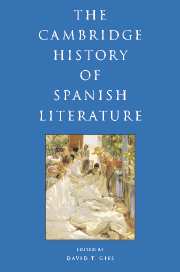Book contents
- Frontmatter
- I INTRODUCTION
- II HISTORY AND CANONICITY
- III THE MEDIEVAL PERIOD
- IV EARLY MODERN SPAIN: RENAISSANCE AND BAROQUE
- V THE ENLIGHTENMENT AND NEOCLASSICISM
- VI THE FORGING OF A NATION: THE NINETEENTH CENTURY
- VII THE MODERN, MODERNISMO, AND THE TURN OF THE CENTURY
- 32 Nineteenth-century women writers
- 33 The Catalan Renaixença
- 34 Great masters of Spanish Modernism
- 35 The poetry of Modernismo in Spain
- 36 Modernism in Catalonia
- 37 Modernist narrative in the 1920s
- 38 Noucentisme
- 39 Ideas, aesthetics, historical studies
- 40 The Catalan Avant-Garde
- VIII TWENTIETH-CENTURY SPAIN AND THE CIVIL WAR
- IX IN AND OUT OF FRANCO SPAIN
- X POST-FRANCO SPANISH LITERATURE AND FILM
- Bibliography
- Index
- References
40 - The Catalan Avant-Garde
from VII - THE MODERN, MODERNISMO, AND THE TURN OF THE CENTURY
Published online by Cambridge University Press: 28 March 2008
- Frontmatter
- I INTRODUCTION
- II HISTORY AND CANONICITY
- III THE MEDIEVAL PERIOD
- IV EARLY MODERN SPAIN: RENAISSANCE AND BAROQUE
- V THE ENLIGHTENMENT AND NEOCLASSICISM
- VI THE FORGING OF A NATION: THE NINETEENTH CENTURY
- VII THE MODERN, MODERNISMO, AND THE TURN OF THE CENTURY
- 32 Nineteenth-century women writers
- 33 The Catalan Renaixença
- 34 Great masters of Spanish Modernism
- 35 The poetry of Modernismo in Spain
- 36 Modernism in Catalonia
- 37 Modernist narrative in the 1920s
- 38 Noucentisme
- 39 Ideas, aesthetics, historical studies
- 40 The Catalan Avant-Garde
- VIII TWENTIETH-CENTURY SPAIN AND THE CIVIL WAR
- IX IN AND OUT OF FRANCO SPAIN
- X POST-FRANCO SPANISH LITERATURE AND FILM
- Bibliography
- Index
- References
Summary
The specificity of the Catalan Avant-Garde can be explained in terms of the tensions that defined the situation of Catalan writers in the first decades of the twentieth century. The two main axes of these tensions were the strong class polarization and the polarization Catalonia–Spain. A third axis, less conspicuous but crucial for the artist’s self-consciousness, was constituted by the range of aesthetic sensibility. Here we find the division between artists or connoisseurs and philistines (or pompiers, to use the prevailing terminology). Never mind that this division was internal to the bourgeoisie; it turned out to be crucial for the appearance of the Avant-Garde. The latter depended on the existence of a well-defined aesthetic milieu whose nomos it could transgress in the name of the sensibility that generated the milieu. The reason for this double game of affirmation and destruction is simple. Art cannot be assailed from outside its own space without the attacker becoming a philistine. Thus the paradox obtains that the insensitive philistine, whom the modernistes had ridiculed in the shape of Rusiñol’s Senyor Esteve (“Mr. Esteve”), now came under fire for defending art – socially legitimated art, that is.
The specificity of the Avant-Garde in Catalonia, as in the rest of the Spanish state, emanated from the narrowness of art’s autonomy. The precariousness of this social space for art, which the modernistes had striven to create, accounts for the “tameness” of an Avant-Garde that could not defect from the commitment to forge a differentiated aesthetic sphere. From this perspective, the Avant-Garde appears as an extension of Modernisme.
- Type
- Chapter
- Information
- The Cambridge History of Spanish Literature , pp. 545 - 552Publisher: Cambridge University PressPrint publication year: 2005

